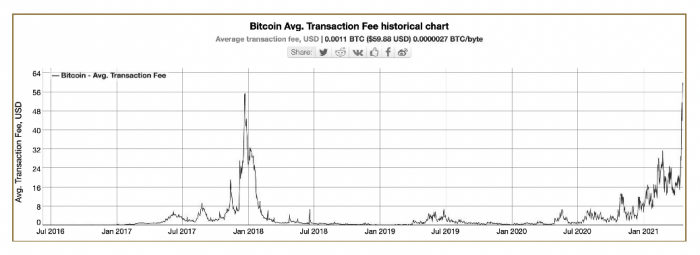Why I Am Not A Bitcoin Investor
I have been slow to get on the Bitcoin train. In truth, I’ve kept a safe distance and watched that shiny Bitcoin engine gain speed and momentum, hurtling through space, careening around corners, all the while gaining more and more white-knuckled followers, hanging on for dear life.
My scepticism has kept me off that train. Something so new, so volatile and, most importantly, so hard to understand is just not where I feel comfortable putting my money. In my experience, not understanding an investment is a good reason not to invest, but that didn’t stop me from watching and waiting for some good critical analysis to balance the hype. Finally, the last year or so has produced some thoughtful commentary.
We all know the internet is full of Bitcoin sensationalism. But this is the article I’ve wanted to find for years: a concise rational explanation of Bitcoin and why it might not be a good investment. I couldn’t find that article, so I wrote it. I won’t pretend to be an expert. This is also not an exhaustive analysis—there’s just too much to cover. But for those who share my scepticism, I hope this will help you understand why your doubts are likely well-founded.
A Short History Of Bitcoin
Bitcoin was the first cryptocurrency. Invented by the mysterious Satoshi Nakamoto, it reimagined money as computer code, independent of banks, governments, and central oversight.
Even though it’s been around since 2009, Bitcoin hit my radar hard in 2017—that was the year it gained traction in popular culture and, not coincidentally, the year its price started to skyrocket. There is no more interesting story in finance than new price highs, and the value of a Bitcoin went from about $1300 to $22,000 that year. Bitcoin millionaires popped up all over the internet almost overnight. Forbes called 2017 “The Year of Bitcoin”.
Then it all came crashing down. By the end of 2018, Bitcoin had lost more than three-quarters of its value. We’re likely all familiar with the story since then: depending on how you look at it, it’s either been a thrilling or nauseating series of surges and crashes. Since the start of 2017, Bitcoin has had a rate of return of 59%. But that’s a little deceiving since it has lost 50+% of its value six times in the last ten years and is currently sitting at only 31% of its peak value just a few months ago.

Who Is Investing In Bitcoin?
I’ve talked to a lot of people about Bitcoin and cryptocurrencies over the last five years. Some were Crypto Converts: usually in their 20s and 30s, they were clearly drinking the crypto Koolaid and talked about it with frenzied enthusiasm. Others, the Crypto Curmudgeons, were usually 50+ years old and saw it as a fad that they didn’t understand but didn’t need anyway. But most were Crypto Curious—they’d heard enough to be interested, and even though they didn’t understand how any of it worked, they’d salivated over the success stories and were afraid of missing out on what might be “the next big thing”.
If it seems like a lot of people bought Bitcoin for the first time in the past year, that’s because they did. It’s hard to watch an asset class rocket higher and higher and not try to grab your little piece of it. Fear of missing out (FOMO) investing is alive and well among crypto investors. According to a study published at the end of 2021, 55% of investors who currently owned Bitcoin began investing within the previous 12 months when Bitcoin was at all-time highs, with an average price over double what it is presently. So, even though Bitcoin’s long-term rate of return is impressive, the fact is that the average Bitcoin investor has been crushed.
Why I’m Skeptical About Bitcoin
Like tulips, railways, and dot-com start-ups of years gone by, Bitcoin fever has been nothing if not contagious. In my hunt for the other side of the story, I have come across 10 big reasons to remain sceptical of Bitcoin as an investment. Most of these apply to other cryptocurrencies, too.
1. Bitcoin ownership is highly concentrated.
One of Bitcoin’s primary value propositions is decentralization, but its ownership is actually highly concentrated, with 95% of Bitcoin being controlled by just 2.4% of the accounts.
2. Bitcoin mining (i.e., processing) is geographically concentrated.
The processing of Bitcoin transactions, commonly referred to as “mining”, is also highly concentrated—although the location of that concentration can change rapidly. By September 2019, 75% of mining operations were in China. Due to government crackdowns, China’s mining operations are now about 20%, while 49% are in the U.S., with Kazakhstan and Russia also having large operations. This concentration poses risks not just to investors but also to the environment.
3. Bitcoin is an environmental disaster.
This is a big one. The verification of every single Bitcoin transaction is dependent upon solving ever more complicated math problems. This verification process is called “Proof of Work” and is baked into the design of Bitcoin. Bitcoin “miners” compete to solve these problems and certify the transaction. The fastest miner wins and receives a small amount of coin in return. As more people use Bitcoin, the complexity of the problems accelerates along with the environmental impact. To make matters worse, 99.99% of the computational work is thrown away since there can be only one winner. It is estimated that Bitcoin’s wasteful processing currently consumes as much energy as the country of Argentina (population 45 million)—an environmental nightmare on a global scale.
4. Massive price volatility.
We all know crypto is volatile, but how volatile? In 2011, Bitcoin lost 99% of its value in one day. From December 2017 to December 2018, Bitcoin lost 84% of its value. It’s common to have gains of five to ten percent in a single day, but Bitcoin volatility is higher than FX, gold or silver. Even after 13 years of public access, Bitcoin has failed to develop price stability. I believe this is because it lacks real utility and so remains primarily a means of speculation. Tulips anyone?
5. Bitcoin transactions are too slow and getting slower.
Related to the computational burden inherent to Bitcoin is the fact that transactions are brutally slow, and getting slower as more blocks are added to the chain and more people attempt to use it. The average transaction takes from ten minutes to two hours. Sometimes they can take one to two days. In the modern world, a currency must be fast and fluid to be functional. Visa’s transactions per second (TPS) are between 1500 to 2000. Bitcoin’s TPS is about five—clearly not a candidate for widespread use. And with more users, the system would get slower, not faster.
6. Bitcoin transactions are expensive and lack price controls.
The cost of Bitcoin transactions depends on both the size of the transaction and congestion on the network. Miners, the ones who process transactions, preferentially select those with the highest fees attached. Thus, when there has been a high load of transactions, supply and demand have driven the cost of those transactions way up, as the following chart shows. I fail to see how Bitcoin could become a common currency when this cost volatility is built into the design.
7. Bitcoin lacks regulation and oversight – i.e., user protection.
Perhaps the biggest argument in favour of cryptocurrencies is that blockchain technology allows transactions to take place without the need for oversight by commercial banks, central banks, or governments. This populist narrative is appealing because the current system certainly has its problems, and they are widely known. But the current system also works, and it works largely because the existence of trusted third parties makes things like crime, ransomware, extra-legal gambling, and sanctions evasion very difficult. Lack of oversight with cryptocurrencies means groups involved in such activities are using them more and more—a net negative for society.

8. Bitcoin is no longer an uncorrelated asset.
In the early days, Bitcoin lacked correlation with equity markets, so you could at least make the argument for including it in your portfolio based on diversification. These days, however, Bitcoin and other cryptocurrencies are positively correlated with stocks and commodities.
9. Poor user experience for Bitcoin holders.
Using dollars is so easy we take it for granted. Using Bitcoin is hard. You need to choose a “wallet”—either “hot”, which is online and vulnerable to hacking or “cold”, which is offline and vulnerable to hardware failure. Then you need to be able to navigate crypto exchanges. Finally, since Bitcoin is not widely accepted as currency, and seems to lack the characteristics that would allow it to be, nearly 100% is exchanged for fiat currency, i.e. dollars. I’ve heard multiple financial industry insiders tell of their own time-consuming and frustrating experiences trying to use crypto and warn that unless you are willing to spend a significant amount of time and energy learning the systems, fraud and accidental loss are very real risks. And unfortunately, when things do go wrong, cryptocurrency transactions are irreversible.
10. The biggest threat to Bitcoin: Better cryptocurrencies.
There are currently more than 20,000 cryptocurrencies in existence, almost half of which are either dead or have zero value. There is simply nothing to stop new ones from popping up because their code is open source which means it can be copied, pasted, and rebranded for the next wave of Crypto Curious buyers. What are the chances that you or I will be able to choose the survivor?
Bitcoin may be the first and most well-known cryptocurrency, but history is full of stories of first-to-market failures. Remember Atari, Palm Pilot, and Netscape? If cryptocurrencies have a role in the future, who knows which one(s) will gain widespread acceptance? Many experts think that, even if crypto is going to be part of our lives, it seems likely that central banks will defend their territory and create superior central bank digital currencies (CBDCs).
The Bottom Line
The fact is that our current monetary system works despite its issues. So, the real question is this: What problem does Bitcoin solve? Cut through all the hype, and the best use-case scenario is that cryptocurrencies can exist independent of government regulation. But here’s the rub: unregulated markets lead to widespread fraud and people getting hurt, and when that happens, regulation becomes necessary. So, the best use-case scenario is self-defeating. The Bitcoin snake is eating its own tail, and I believe we’re starting to see this play out in the last few months.
Cryptocurrencies are early—painfully early. The potential for blockchain technology is real and exciting in many ways but staking good money on a prediction of where this is going to lead seems foolhardy to me. It’s like hearing in 1983 about computers being able to talk to each other over long distances and predicting Amazon.
If it fits within their financial plan, I wouldn’t criticize anyone for having a little play money in crypto—it’s fun to be involved in something so new and exciting. But it’s not for me, and if it’s not for you, I hope this article helps you feel better about that decision.
Matt Poyner is a Do-it-Yourself (DIY) investor, flat-fee financial mentor and planner for other DIY investors and blogs at www.DividendStrategy.ca.

